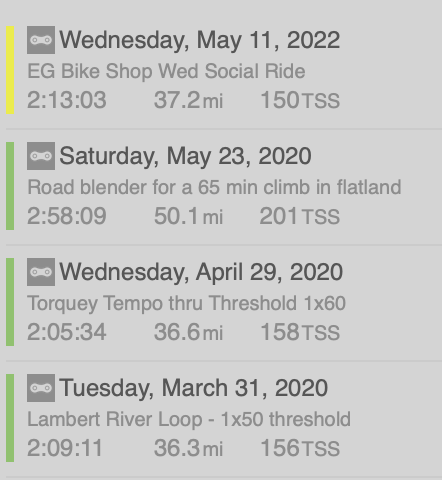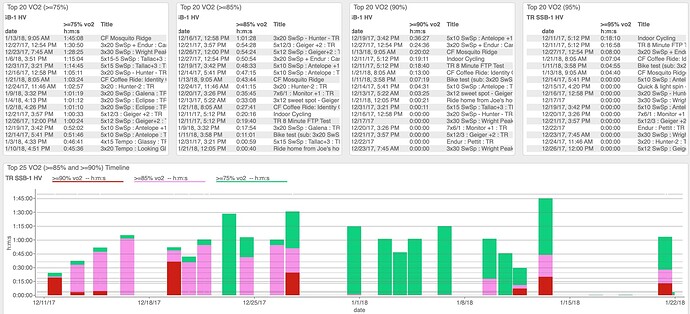I don’t think LT1 works this way.
No, it does not. But if you want to relay on your percentages of FTP, under is better than over. But basically you are ending up in 4 zones model: easy (feel), moderate (you can use percentage to plan how long you will go with your intervals - is it 40min TiZ or 120 min TiZ, or how you feel at a given day), waterboarding aka vo2 max (feel), all-out (your powermeter will go brrrrr, just smash it). But this is only my personal opinion and I use it in my training and I do not have any cretendials to back it up.
Yes!
Although I’m an expat living in Japan, and have lived in the US and Canada as well. Why? ![]()
Maybe. But the results in the Gollnick paper (in terms of the absolute magnitude of improvement) are compelling. The whopping increases in muscle glycogen, succinate dehydrogenase, phosphofructokinase for such a simple protocol were amazing. So, a lot of the time, I think we just rationalize away the effectiveness of this type of workout because it breaks our will…not because the workout isn’t exceptionally effective.
It’s a 40km TT for me, which is relevant to an Olympic triathlon.
It seems like I can always identify germans! Not an insult. My children are half German!
For those with WKO, this “meanmax(power, 1:00:00)>0.9*bikeftp” returned an interesting list of workouts.
Translated, it returns a list of workouts where max 1 hour average power was greater than 90% FTP.
Looking at the recent list:

and comparing it to my best season:
makes me think I’ve gotten soft. Given my progress so far this season, maybe it is time to #HTFU again.
Even more interesting to play around with related search terms
- 1 hour avg power > 90% FTP (meanmax(power, 1:00:00)>0.9*bikeftp)
- 40 minute avg power > 95% FTP (meanmax(power, 1:00:00)>0.9*bikeftp)
- 30 minute avg power > 98% FTP (meanmax(power, 1:00:00)>0.9*bikeftp)
the first and last return almost the same list. And then looking at each workout’s time at 85+% relative eVO2max.
Yeah I suspect doing anaerobic workouts by percentages of FTP don’t work well for a good portion of cyclists. My piddly 275 FTP has me doing 30-30’s at 150% which would be a level 8 for TR, but it would probably be a 6/10 RPE for me. But that’s the point of AT, right? Disassociating power zones from strict adherence to FTP, I assume AT would take that survey response and give me something more difficult next time around.
No…given that workouts are always a % of “ftp”, there’s no way to accommodate for a distinct rider profile.
Let’s say AT resets my levels after a FTP bump and gives me a level 1.5 anaerobic workout after a FTP bump, the following anaerobic workout next week is a 1.7. I complete the 1.5 workout and mark the survey response “Easy”. My understanding is that AT would update that following 1.7 workout to a level 2+, wouldn’t it?
Granted this doesn’t matter if you’re a heavily anaerobic athlete, I know we’re outliers and AT probably doesn’t have the dataset to properly take us into account but I’m hoping the TR folks are working on something. Maybe someone who’s really anaerobic and has gone through a crit specialization can comment on how AT changed as the period went on. I would assume at some point AT would figure out that you’re probably off the chart but it wouldn’t be until too late, i.e. by the end of the specialization phase.
What would be the difference in these 2 workouts (1.5 vs 1.7)?.
What one would need is the same workout but higher/lower power targets, not more time in zone.
I’m not knowledgable enough to follow the mechanistic aspects, but I’d be skeptical for several reasons. Riding for 1 hour at FTP without break is much more fatiguing than riding 1 hour even at high sweet spot. That’s because if your FTP is set correctly, you’ll be right at the razor’s edge of what your body can do with nothing to spare and no rest in between. It isn’t an illusion or purely psychological that 1x60 minutes is harder than 3x20 minutes even though at the end you spend the same time at threshold.
The second thing is that the ability to ride 60 minutes at threshold is a specialized skill that suits only particular types of events. For other events this is a strength that you cannot use. Yes, also other forms of fitness will improve with this, but at the same rate than if you were to target other skills specifically? I don’t think so. If you race crits, building your short power is much more important (not just in absolute terms, but also the amount of energy you can expend above threshold).
Of course, if you like this kind of stuff or are naturally good at it, good for you. If you want to train it: more power to you. But it may not be the best investment of your time.
No offense taken ![]()
What a coincidence, so are mine ![]()
![]()
Yes, but there is variation. So e. g. there might be variants of the same VO2max workout at 115, 118, 120, 122 and 125 % of FTP. But you should at the end stay in the same power region.
That’s a good question and I don’t have time to look into how AT decides which workout to update to. Maybe a TR team member can comment on that.
Ah, I see. I was under the impression that AT looks at power profile too.
The second thing is that the ability to ride 60 minutes at threshold is a specialized skill that suits only particular types of events. For other events this is a strength that you cannot use.
Agreed it’s very specialized. I can hold 275 watts for about 90 minutes but that doesn’t really help me on the Saturday ride through the rolling hills.
I’m not a highly aerobic athlete which is exactly why I want to train it. I know I can do 3x20’ but the 1x60’ is a good gauge of my aerobic fitness and mental strength. I agree though, it’s grueling and better left to when you’re mentally and physically prepared for it.
Its pretty simple protocol:
Paper: “Effect of Training on Enzyme Activity and Fiber Composition” Gollnick, Armstrong, Saltin, et al.
FWIW here my estimated/relative % vo2max (WKO5) during the time I did TR’s pre-AT SSB 1 High Volume:
It wasn’t that hard doing an hour at 75% estimated vo2max, multiple days a week. It did kinda suck the fun out of cycling, but I did end up with incredible strength endurance. But not much else.
Yeah, and if you are out and about, learning pacing is probably a much better skill to have than riding 60 minutes at one given power level. Because even for real-world 40k TTs or hill climb TTs you won’t hold the same power for the entire event. Most commonly you’d do a negative split during a 40k TT (unless wind and terrain suggest otherwise).
Sounds to me you are using that as a fitness assessment rather than a training unit. Which is completely fair and a good use of your time if that interests you or is relevant to your riding. For that it can be perfect. I’d just not want to use it as a training unit for a broad audience.
That seems terrifically effective (not that I had any doubt that it would be).
I’ve done a few of the high level almost 60min TR Threshold workouts. They were tough, and also highlighted what I already knew which was that my MLSS and FTrainingP are not the same. At least in TR with AT.
I never did SS higher than 90% at that point (late last year) and so riding at threshold for up to an hour was a novel and effective stimulus. Now I’m playing with riding at higher percentages of FTP so that’ll be interesting to compare once I can get back on the bike and find out how my “Threshold” fitness might have changed.
I think there’s absolutely value in progressing upwards from 20min Threshold intervals, but it really relies on having a pretty good understanding what your MLSS is and whether it’s less than your FTP. Especially if your racing involves any form of muscular endurance.
Seems like a bit of a rosy painting of a 1973 study with no control group and only 6 individuals being studied all of whom had at least 2 years away from endurance training before the onset of the study. They all got better doing a bunch of hour efforts, but they probably all would have gotten better with any organized endurance training - the study can’t say anything about trained athletes and only very little about untrained athletes. It seems like the type of study you do to get baseline information for hypothesis generation.


